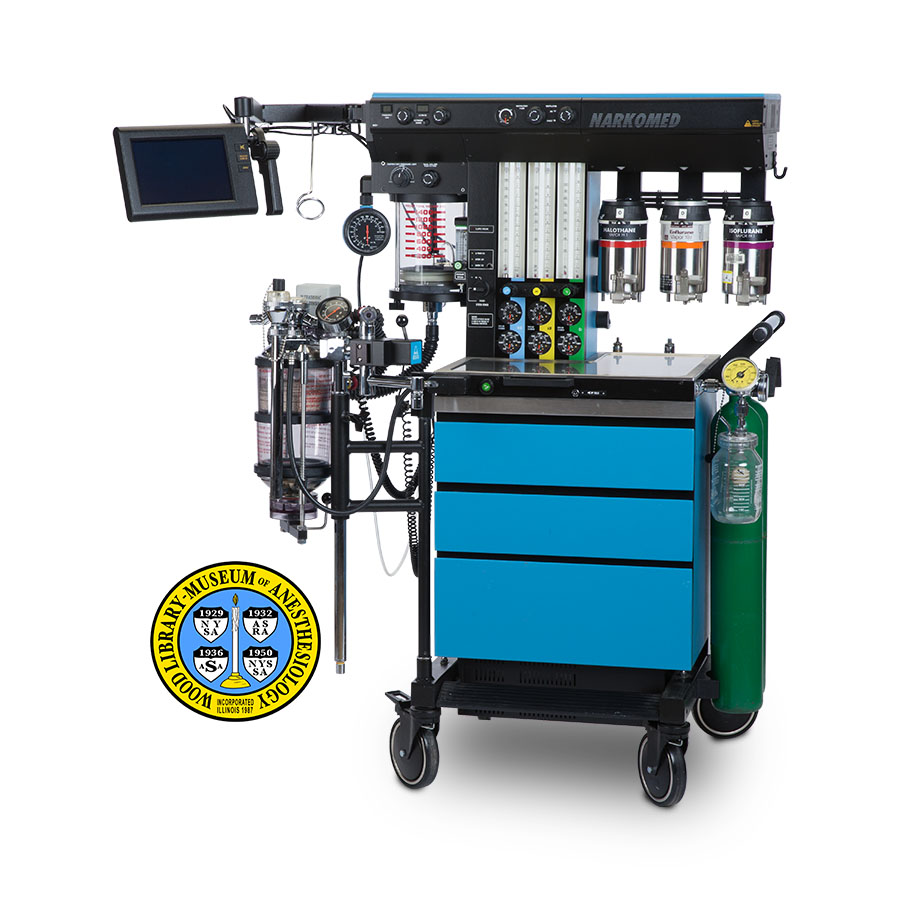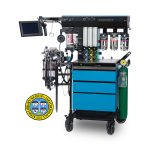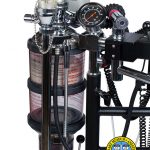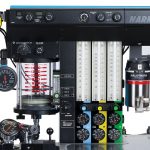Narkomed 2C
North American Dräger (NAD) was co-founded in 1968 by engineer Peter J. Schreiber in Telford, Pennsylvania, with financial backing from the West German company, Drägerwerk. Mr. Schreiber became a driving force for the advancement of anesthesia machine design and patient safety. In 2004, the Society for Technology in Anesthesia gave him the J. S. Gravenstein Award for lifetime achievement in that field. NAD's first clinical anesthesia machine, the Narkomed 1, was introduced in 1972.
The Narkomed 2C was manufactured from 1993 through 1999. It was equipped with an electronic ventilator, a sphygmomanometer, double-canister absorber with positive end expiratory pressure (PEEP) valve, oxygen ratio controller and a battery backup. It could deliver one of three liquid anesthetics from Dräger Vapor 19.1 vaporizers, as well as nitrous oxide and oxygen. Like the earlier Narkomed 4, it featured a flat screen monitor that was mounted on a boom. But while the model 4 had three monitors, the 2C had only one, which collected and displayed oxygen concentration, breathing pressure and respiratory volume information.
The machine was designed to interface with as many as five expansion devices, including additional monitors of respiration and other patient vital signs, as well as hospital information systems. The model 2C was also available as a ceiling-mounted workstation.
Catalog Record: Narkomed 2C Narkomed 2C
Access Key: aqla
Accession No.: 2014-02-15-1 H
Title: Narkomed 2C / North American Dräger.
Corporate Author: North American Dräger.
Publisher: Telford, PA : North American Dräger, [between 1993 and 1999].
Physical Description:1 anesthesia machine : metals, plastics, rubber ; 144 x 109 x 76.5 cm.
Subject: Anesthesia, Inhalation – instrumentation.
Subject: Anesthesia Machines.
Subject: Enflurane.
Subject: Halothane.
Subject: Isoflurane.
Subject: Monitoring, Intraoperative – instrumentation.
Subject: Vaporizers.
Subject: Ventilators, Mechanical.
Note Type: General
Notes: The title is based on the donor’s identification of the object, and the manufacturer’s product literature. The date range is based on the first and last years of this model’s production, as stated by Clark (2006).
Married to gas cylinders from the parts collection for the purposes of photography.
Note Type: With
Notes: With one Dräger Vapor 19.1 halothane vaporizer, serial number “+ARLD-0365”; one Dräger Vapor 19.1 enflurane vaporizer, serial number “19211”, and one Dräger Vapor 19.1 isoflurane vaporizer, serial number “ARJF-0072”.
Note Type: Citation
Notes: Clark R. Vaporizer-selection system malfunction in the Dräger Narkomed 2c system. [Correspondence]. Anesthesiology. April, 2006;104(4):891-892.
Note Type: Citation
Notes: Kee SS, Frenzel JC, Goravanchi F, Laman KA. Vaporizer-selection system malfunction in the Dräger Narkomed 2c system. [Correspondence]. Anesthesiology. April, 2006;104(4):891.
Note Type: Citation
Notes: North American Dräger Company File. Archives. Located at Wood Library-Museum of Anesthesiology, Schaumburg, Illinois.
Note Type: Citation
Notes: Yoder J. Operating Principles of Narkomed Anesthesia Systems. Telford, PA: North American Dräger, 1993.
Note Type: Physical Description
Notes: The housing of the machine is made of metal panels that are enameled blue; The machine has a stainless steel tabletop, with three drawers below it; The cabinet is mounted on four wheels, each of which can be locked by a foot pedal; Mounted above tabletop, the flowmeter bank contains six tubes; The two on the far left are marked “N2O”, the two in the center are marked “AIR” and the two on the far right are marked “OXYGEN”; Each set of two tubes is associated with a control knob and a pressure gauge with the same markings;
Left of flowmeter bank XX marked, from top to bottom: “READ CENTER OF BALL, 10, 8, 6, 4, 2 [new line] AUXILIARY OXYGEN”;
To the left of the pair of nitrous oxide tubes, the flowmeter bank holds the following elements, from top to bottom: a warning light marked “O2 SUPPLY PRESSURE”, a warning light marked “AC POWER FAIL”, another light marked “BATTERY LOW”, a third marked “BATTERY TEST”, and the battery test button; A dial marked “SYSTEM POWER”, with two settings: “ON” and “STANDBY”; Several components are mounted on the left side of the upper section; A folding armature extends from the left side of the machine; This armature holds a computerized monitor; A metal bar extends from the right side of this section; This bar can hold as many as three vaporizers;
Below the tabletop, the wall on the right holds a connector marked “VACUUM” and two yokes marked “O2”; The back wall holds, from left to right, two yokes marked “N2O” and one yoke marked “air”; A double-decker absorber contains soda lime in the upper chamber; The absorber’s pop-off valves are marked “INSPIRATION” and “EXPIRATION”, respectively; Additional features include a ventilator ‘and ventilator alarm, suction bottle, and “Ultrasonic Flow Sensor”.
Note Type: Reproduction
Notes: Photographed by Mr. Steve Donisch, June 21, 2017.
Note Type: Acquisition
Notes: Gift of Mr. James Yoder.
Note Type: Historical
Note: North American Dräger (NAD) was founded in 1968 by engineer Peter J. Schreiber and two partners in rural Telford, Pennsylvania, with financial backing from the West German company, Drägerwerk AG. Before emigrating to the U.S. in 1966, Schreiber worked for Drägerwerk designing anesthesia equipment. The first products sold by NAD were anesthesia machines for veterinary care and anesthesia accessories, such as the Dräger Volumeter (for measuring respiratory volume) and Narkotest-M (for measuring halothane concentrations).
Mr. Schreiber became a driving force for the advancement of anesthesia machine design and patient safety. In addition to his patents, Schreiber authored papers in peer-reviewed journals as well as books on anesthesia machine design and safety. He was a member of the Anesthesia Patient Safety Foundation (APSF) from its inception in 1985, and served on its board in 1998. In 2004, the Society for Technology in Anesthesia awarded him the J. S. Gravenstein Award for lifetime achievement in that field.
NAD’s first clinical anesthesia machine, the Narkomed 1, was introduced in 1972. The Narkomed 2C was manufactured from 1993 through 1999. The model 2C was equipped with the Dräger AV-2 electronic ventilator, a sphygmomanometer, double canister absorber with positive end expiratory pressure (PEEP) valve, oxygen ratio controller and a battery backup. It held three vaporizers, and could deliver oxygen and nitrous oxide either from compressed gas cylinders or from a pipeline system. The cataloged object also is equipped with an optional suction apparatus.
Like the earlier Narkomed 4, introduced in 1990, it featured a flat screen monitor that was mounted on a boom. But while the model 4 had two additional monitors, the 2C had only the one, which collected and displayed oxygen concentration, breathing pressure and respiratory volume information. The machine was designed to interface with as many as five expansion devices, including additional monitors of respiration and other patient vital signs, as well as with hospital information systems. All data from these expansion devices could be displayed on the single screen, but not simultaneously. The model 2C was also available as a ceiling mounted workstation.
Note Type: Exhibition
Notes: Selected for the WLM website.




